Querstr. 16
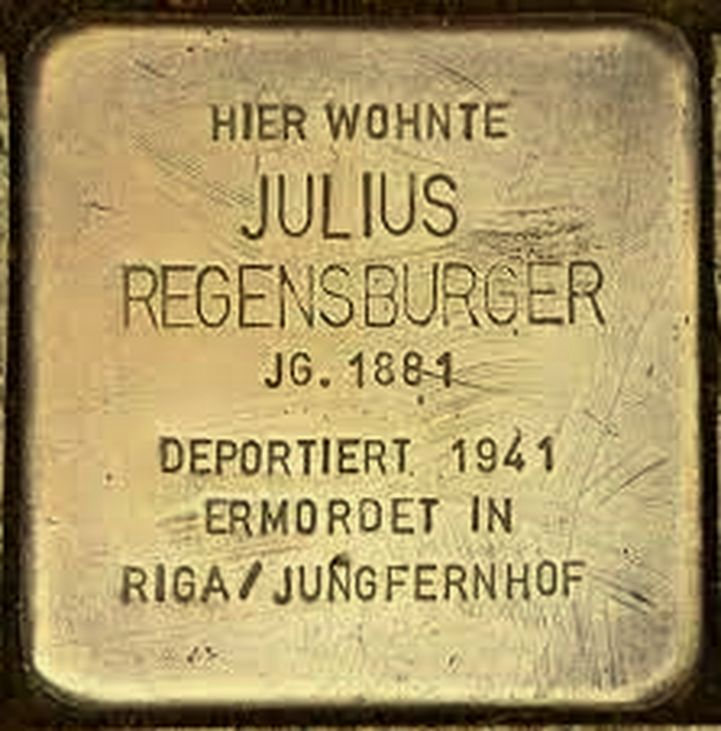
The father of Julius Regensburger was a cattle dealer who owned his own business. Many Jewish citizens – Dr. Aron Tänzer lists more than twenty names in his book ‘The History of the Jewish People in Jebenhausen and Göppingen’ – practiced this profession. According to the Jewish religion, God rested on the seventh day of creation, the Sabbath. This day is sacred for people of Jewish faith; they are encouraged to abstain from any work and to spend their time reading the Torah. However, Jews could not follow the rules of their religion if they worked for a Christian employer because they would have had to work six days from Monday through Saturday. Therefore many decided to become self-employed in their profession, just as Julius Regensburger’s father did.
Collaboration of Jews and Non-Jews in the Cattle Trade
Shortly after Baron von Liebenstein permitted ‘Schutzjuden’ [Jews under special protection] to move to the area in 1777, Jonathan, the founding father of the Regensburger family, settled in Jebenhausen with his family. Just as in other regions of Germany, the economic opportunities for the Schutzjuden of Jebenhausen were mainly in trade. They were not tied to their property like the native farmers but were able to earn their living as traveling merchants or as cattle dealers. At the end of the 18th century, new breeds of livestock and cattle started to appear at cattle markets, which led to an economic upswing at the trading locations. The farmers were tied to their farms by their everyday chores. This made it impossible for them to go on the long trips to the markets in order to buy or sell cattle, so they delegated Jewish cattle dealers to act as middlemen. Jewish butchers worked hand in hand with Jewish cattle dealers. They had to have special training for their occupation of ‘Schächten’ [kosher butchery]; therefore they were regularly examined to see if their religious lifestyle was up to the high standards of a licensed kosher butcher. The condition of their butcher knives was checked regularly so that the proper killing of the animals could be assured. Only meat that was completely drained of blood was considered ‘clean’ (kosher) and complied with the dietary rules of the Thora. Because of the good cooperation between Jewish cattle dealers and butchers and of the high standards set for qualification in these professions, following the rules of kosher eating could be guaranteed – then as well as today.
Kosher restaurants sprang up in the vicinity of the cattle markets. By-products such as furs, skins, leather or fat were also traded. The market places gained considerable importance. At first the non-Jews were suspicious of the cattle and fur merchants because of their Jewish customs, for example they did not go to market on a Saturday, and they communicated with each other in their own language which was usually spoken among the cattle dealers and was a derivation of Hebrew. But they were experts in their field, asked reasonable prices and treated their customers fairly who in turn became less suspicious of them. More and more, Jewish cattle dealers acted as middlemen, traveled far and wide, bought cattle from the farmers and sold them to other farmers or butchers. These business relations between Christian farmers and Jewish merchants sometimes lasted for several generations, and this explains why Jewish cattle dealers were represented on average at a higher rate in the rural areas surrounding Goeppingen than in other parts of the country.
In 1864 the Jewish population in Wϋrttemberg was granted equal legal rights, and the Israelite church authorities received permission to found their own independent religious community in GGoeppingen. This is why cattle dealer Adolf Regensburger moved from Jebenhausen to the nearby town Goeppingen.
Julius Regensburger’s Life Prior to 1933
Julius Regensburger, the first-born son of Adolf Regensburger and his wife Rebekka, née Bär, grew up at Sauerbrunnenstraße 18. The house which his grandfather had built on August 30, 1881, four years before Julius was born, was small and built simply. It was not worth keeping up. When the machine factory Louis Schuler took over the property in 1912, the house was torn down to make more room on the firm’s grounds. Together with his son Julius, Adolf Regensburger relocated the cattle dealership to a rental property at Pfarrstraße 46.
Adolf Regensburger died in December 1917. The name of his son Julius does not appear again in the Goeppingen address book until 1927. Where had he been in the meantime, and what did he do? Did he live in Paris after 1919 like his brother and try to find his luck there? There are no answers to these questions because of the lack of information about Julius Regensburger.
There are only sparse insights into his later life too. In 1927 Julius Regensburger came back to Goeppingen and moved into an attic room at Querstraße 16. His landlords were Wilhelm and Pauline Hiller who ran a restaurant and pub in the same building. A restaurant and pub? Actually, the main business of Wilhelm Hiller was to bake and sell bread. But besides the bakery store and the oven which was built into the main area on the ground floor, there also was a small room which was just big enough for three tables. It was enough for the ‘Wirtschaft zum Blumenstrauß’ [restaurant/pub named ‘Bouquet of Flowers’] and became a favorite meeting place for young and old.
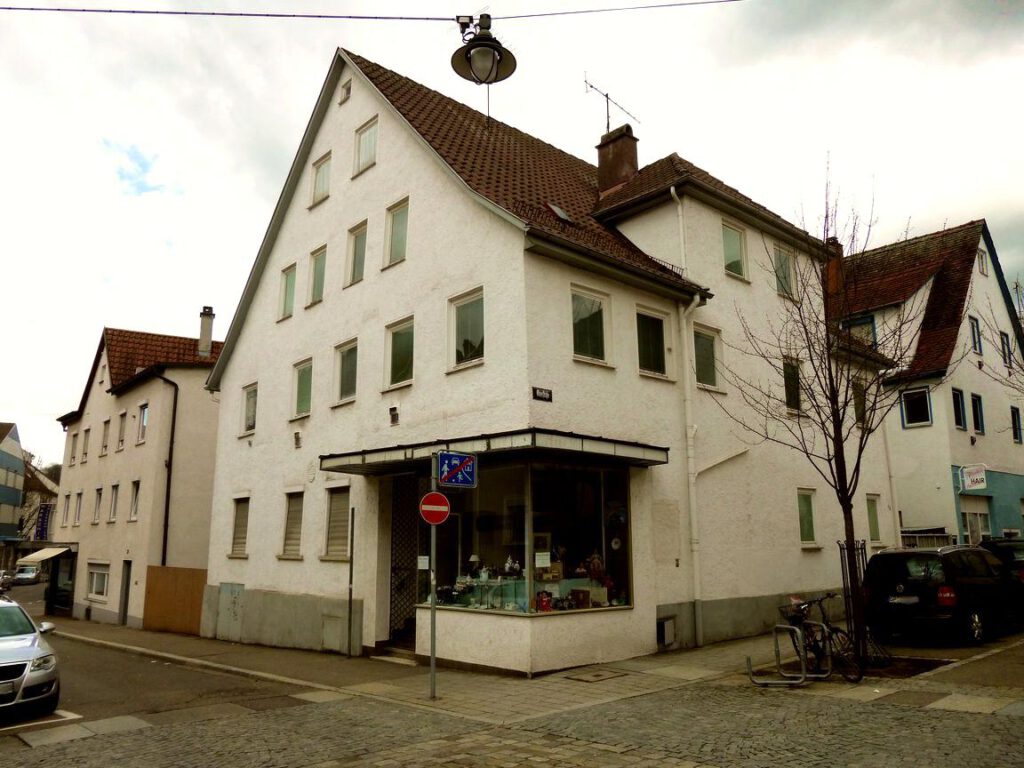
Everyone felt comfortable in the familiar and cozy atmosphere of the ‘Sträußle’ [Swabian for ‘Little Bouquet of Flowers’]. Even the wives didn’t mind if their husbands were steady customers there. They could be assured that they would not be staying out until late into the night but would leave and go home early, because baker Hiller needed to get his sleep. Such small restaurant/pubs connected to stores were common in Goeppingen. When it closed in 1986, many customers missed their ‘Ado’ restaurant which the Adomeit family had taken over from the Hillers in 1953.
Julius Regensburger apparently felt very comfortable in his attic room above the ‘Sträußle’ which he rented for eleven years. During the summer of 1938 he moved out – but not of his own free will!
His Life After 1933
The merciless actions of the Nazis to exclude Jews from the economic life of Germany forced him to do so. Julius Regensburger was trained as a merchant and started his own business selling oil and fat in 1909. It is not known in which type of fat and oil he was dealing with. It can be assumed that it was kosher fat and cooking oil because these were – and still are – prepared according to Jewish food laws according to specific ritual regulations. Orthodox Jews cannot cook or eat a meal that has been prepared with pork fat. Because Julius Regensburger started his business while his father was still alive and he had contacts with butchers and specialty stores, he was able to deliver merchandise which met the requirements for pureness. Kosher restaurants and specialty stores as well as private customers purchased these products. He might also have sold lubrication oils which were needed by Jewish cattle dealers for their wagons and later, when they were motorized, for their trucks.
Julius Regensburger remained unmarried and did not have to feed a family. But despite this, the measures the Nazis introduced affected his business so severely that he could barely live on the proceeds from his work as a sales representative. Starting in 1935 the commercial licenses of Jewish cattle dealers were cancelled and anti-Semitic hate tirades destroyed the business relations between Christian farmers and Jewish cattle dealers. They became impoverished and along with them people who worked in related businesses, like Julius Regensburger. In a letter from December 1939 to the Martin Brothers Bank he described his dire situation: “I herewith confirm that my business of selling oil and fat can no longer be conducted profitably, and my brother-in-law Julius Dörzbacher has allowed me to live at his residence with free room and board since August 1938. Since that date he has contributed to my living expenses. On the 12th of July 1939 he loaned me the amount of RM 1,674.15 to cover the cost of equipment.”
Hermine, Julius Regensburgers sister, had married Julius Dörzbacher in 1912. According to the Swabian saying ‘The same belongs to the same‘ she had married into the Dörzbacher cattle merchant dynasty. The brothers Samuel and Leopold Dörzbacher from Jebenhausen had a cattle dealership in Goeppingen since 1885.
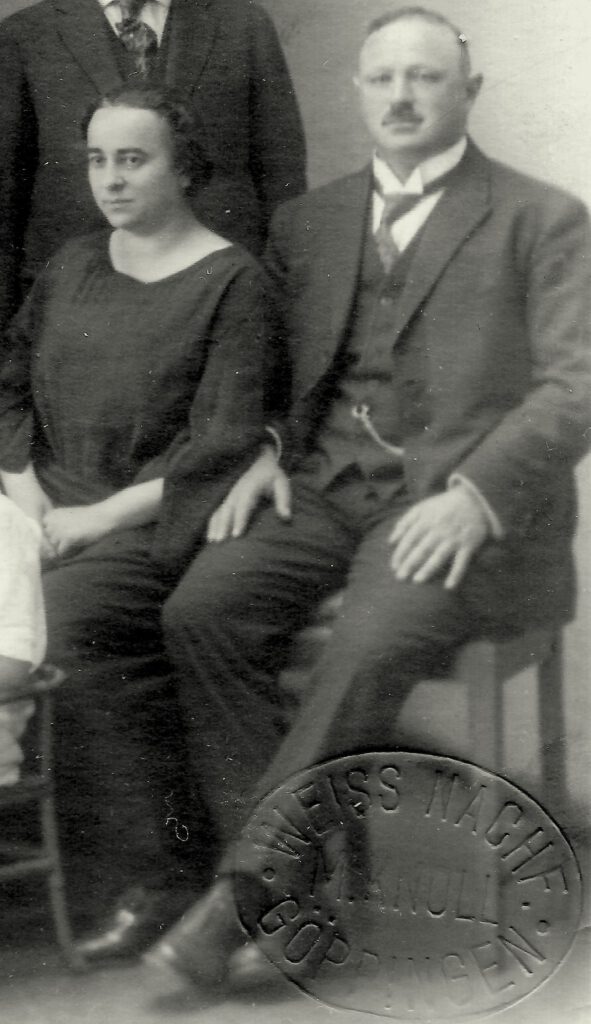
The business was profitable, and the brothers had ‘master builder’ Kϋbler build a spacious house for them at Geislinger Straße 6. It was equipped with fourteen gas lights as well as a water pipeline with four ‘faucets’ which lived up to the most modern tastes of that time. On the ground and second floors, there each were apartments with four rooms and an additional parlor, and in the attic there were six additional rooms. The house was large enough for many occupants. This was a necessity because Samuel Dörzbacher had ten children, and his brother Leopold, who had already died in 1896, had three. Samuel survived his brother by many years. Surrounded by his family, he celebrated his 75th birthday in 1926. This celebration in his honor was documented in a photograph. He died in 1931 at the age of 80, and his wife followed him into death two years later.
The house with the stables and shop buildings, which stretched all the way to Gartenstraße, passed into the ownership of Dörzbacher heirs. Sigmund, another brother of Samuel, had moved into a more modest house next-door at Geislinger Straße 8 in 1912. Sigmund also was a cattle dealer.
Julius Dörzbacher, the third child of Samuel and Hannchen Dörzbacher, moved to Bahnhofstraße 28 after his marriage to Hermine, née Regensburger. He rented a building from Netter & Eisig and opened a horse and cattle dealership there, following the family tradition. In 1924 the couple purchased an old building at Wühlestr.23, which was in dire need of renovation and which he mainly used as a stable.
Brother-in-law Julius Dörzbacher and his wife Hermine supported Julius Regensburger financially as well as they could, also after they were able to emigrate to England in the summer of 1939. All nine siblings of Julius Dörzbacher managed to emigrate with their families. Why Julius Regensburger did not have or did not take the opportunity to leave Germany cannot be explained.
It is also unclear why Julius Regensburger was not arrested during the pogrom night of November 9-10, 1938, although his age threatened him with this fate. His brother-in-law Julius was one of the 27 Jewish men from the town who were taken to the Dachau concentration camp on November 12, from where Julius Dörzbacher was only allowed to return after a month of torment.
After the departure of his sister to England, Julius Regensburger moved to Geislinger Straße 6, the birth place of his brother-in-law. Beginning in 1939, different renters began moving into that house. After the death of Samuel and his wife, citizens of both Christian and Jewish religions had lived together under one roof, now there were more and more Jewish renters. Because their own houses had been confiscated or they were evicted from their apartments, they were now assigned space in the house, in the workshop, in the stables and other areas. They were barred from the ground floor apartment because Marie Bauer, a seamstress, had rented this space since 1932 to house her tailor’s workshop. Living space became tight on the approximately one-quarter acre area. It is not possible to ascertain how many Jewish men and women from Goeppingen had been forced to live there together.
Eleven of them, among them Julius Regensburger, were ordered to report to Schiller School in Goeppingen on November 28, 1941. None of these deportees survived, they were murdered by the Nazis in Riga.
Among Julius Regensburger’s close relatives, his cousin Jakob Regensburger, born in Goeppingen in 1890, also lost his life. Jakob, who had lived at first in Stuttgart, later in Frankfurt/Main since 1919, was deported from Drancy (France) to Auschwitz and murdered in August 1942.
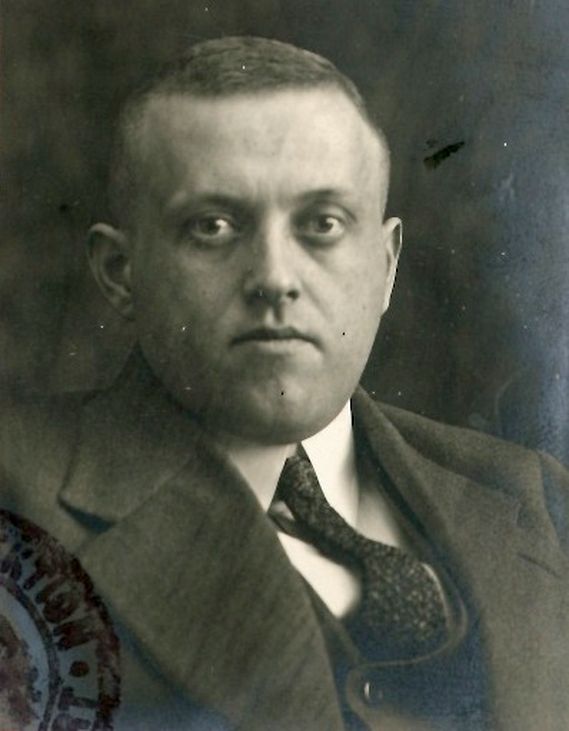
On September 19, 2012, Gunter Demnig placed a Stumbling Stone in memory of Julius Regensburger in front of his former home at Querstraße 16. Unfortunately the original house had to make room for a new building.
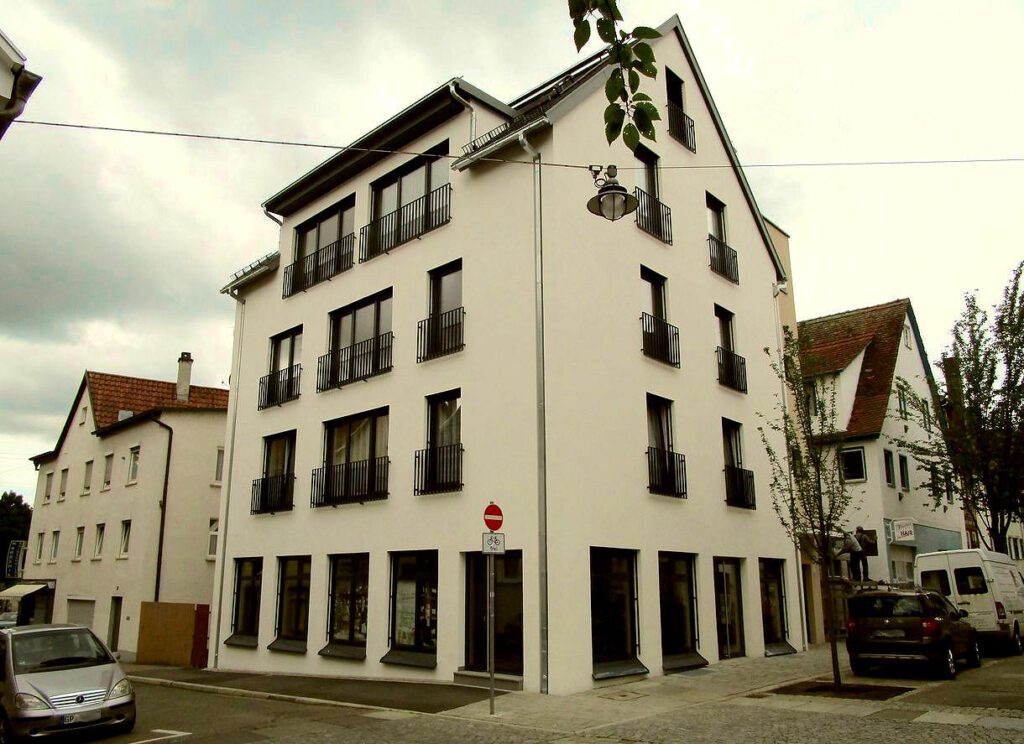
(17.04.2023 clm / ir)


Hello,
Firstly, thanks so much for your project and the work you do. I was very happy to come across your page remembering those in Göppingen because several of the articles here mention family members I’ve been doing research on.
My name is David Dorzback, and my great grandfather was Ludwig Dorzback (Dörzbacher). He was the son of Samuel/Hanna Dörzbacher, and one of the brothers of Julius Dörzbacher.
I have been researching him and that side of my family lately, so it was nice to learn more about them here.
I wanted to asked about a photograph you mentioned in the article. The article mentions there was a celebration for Samuel Dörzbacher’s 75th birthday, and a photograph exists of the occasion. Would it be possible for this photograph to be shared with me? Or could you point me in the direction of the archive that might have it? Samuel Dörzbacher was my great great grandfather, and I’d very much like to have the picture!
Or if there’s any other information you’re able to share with me on my family from this time, I’d be extremely grateful. I don’t speak German, so searching through archives has been somewhat difficult at times. If there’s any photos/documents/records/etc. you have available to share on the Dörzbacher family, I would very very much appreciate it!
Also, on a different note, I just thought I’d share some things I came across regarding Julius Regensburger while researching my family.
I found several items in the Staatsarchiv Ludwigsburg archive while searching for records on my family. Link:
https://www2.landesarchiv-bw.de/ofs21/home.php
There is an individual case file for Julius Regensburger from the “Baden-Württemberg State Office for Restitution” (File: Staatsarchiv Ludwigsburg EL 350 I Bü 25881). I should be receiving this record along with some others I’ve requested from the archive soon.
There’s also another record for him, “Stuttgart Regional Finance Directorate: files on asset control, Nazi assets and restitution, with previous provenance. Göppingen Office” (File: Staatsarchiv Ludwigsburg EL 402/9 Bü 295).
Interestingly, on this record, Wilhelm and Pauline Hiller (Julius’ landlords according to the article) are mentioned the document’s title under the record ‘Details’. It says:
“Titel: Dörzbacher, Julius u. Hermine, geb. Regensburger
Besitzer: Hiller, Wilhelm u. Pauline, geb. Ampssle”
I requested this document too, but the archive told me it was approx. 350 pages, and based on their fee structure it’d cost 175 euros for a digital reproduction to be scanned. I had to pass on obtaining this one due to the cost unfortunately.
I’m not sure if any of this information is useful to at all, but I just thought I’d share it in case it was of interest to anyone.
Thank you so much for taking the time to read my message. And please do reach out if the aforementioned photograph or other information on the Dörzbachers is available. Have a great day!
Dave Dorzback
daviddorzback@gmail.com